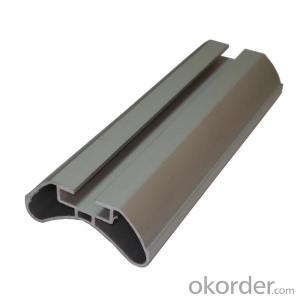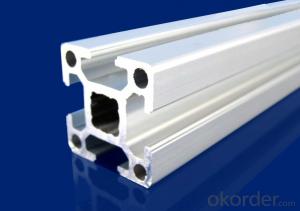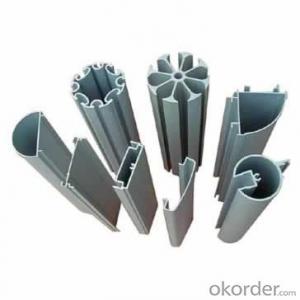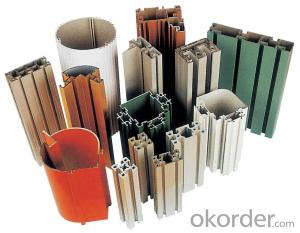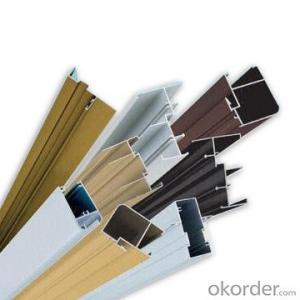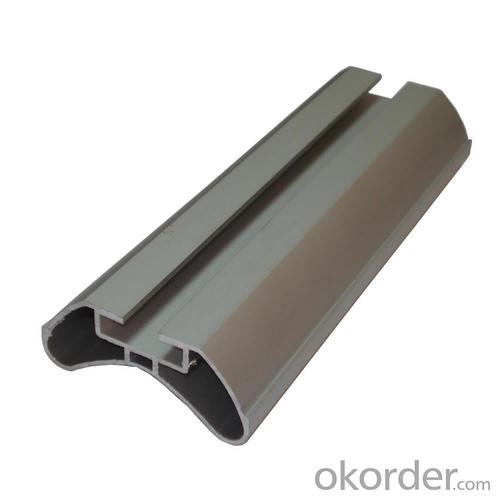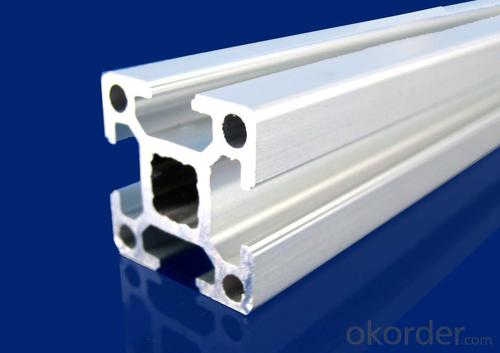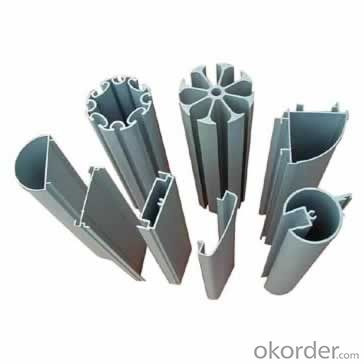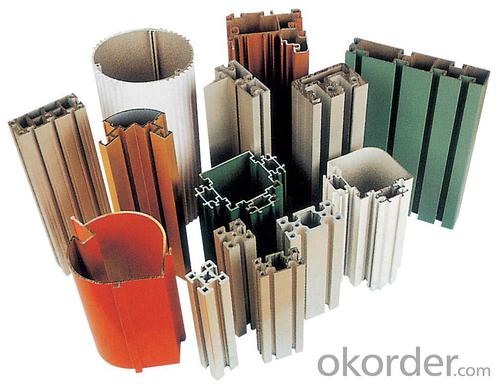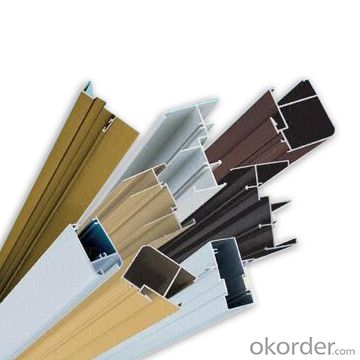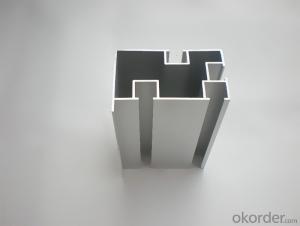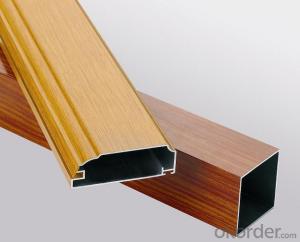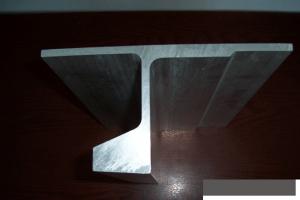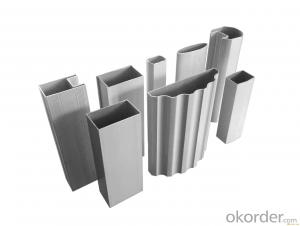Aluminum Strut Profiles 6061 Aluminum Profile Extrusion
- Loading Port:
- China Main Port
- Payment Terms:
- TT OR LC
- Min Order Qty:
- -
- Supply Capability:
- -
OKorder Service Pledge
OKorder Financial Service
You Might Also Like
Aluminium is a relatively soft, durable, lightweight, ductileand malleablemetalwith appearance ranging from silvery to dull gray, depending on the surfaceroughness. It is nonmagnetic and does not easily ignite. A fresh film ofaluminium serves as a good reflector (approximately 92%) of visible lightand an excellent reflector (as much as 98%) of medium and far infraredradiation. The yield strength of pure aluminium is 7–11 MPa,while aluminium alloys have yield strengths ranging from200 MPa to 600 MPa. Aluminium has about one-third the densityand stiffness of steel. It is easily machined,cast, drawn and extruded.
Aluminium alloys (or aluminum alloys; see spellingdifferences) are alloysin which aluminium(Al) is the predominant metal. The typical alloying elements are copper, magnesium,manganese,silicon,tin and zinc. There are twoprincipal classifications, namely casting alloys and wrought alloys, both of which are furthersubdivided into the categories heat-treatableand non-heat-treatable. About 85% of aluminium is used for wrought products,for example rolled plate, foils and extrusions.Cast aluminium alloys yield cost-effective products due to the low meltingpoint, although they generally have lower tensile strengthsthan wrought alloys. The most important cast aluminium alloy system is Al–Si,where the high levels of silicon (4.0–13%) contribute to give good castingcharacteristics. Aluminium alloys are widely used in engineering structures andcomponents where light weight or corrosion resistance is required
Features:
Material | Alloy 6063,6061,6005or according to customer’s choice |
Temper | T3, T4, T5, T6 |
Surface | Anodize, electrophoresis, powder coating, PVDF coating, wood grain painting, matted, etc. |
Length | Coating 6.5 meters, Anodizing 6.5 meters, Mill finish 5 meters |
Application | Industrial, electrical equipment(TV set, air conditioner, refrigerator, computer), decoration,construction, transportation |
Custom Made | We can package following with customer's request. |
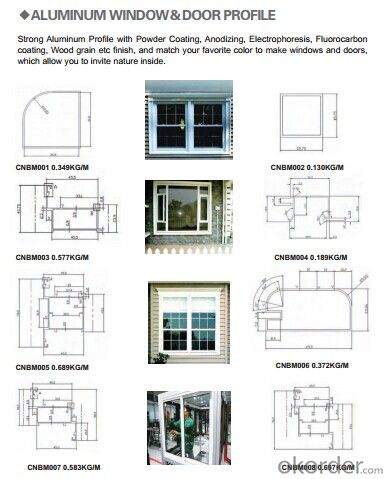
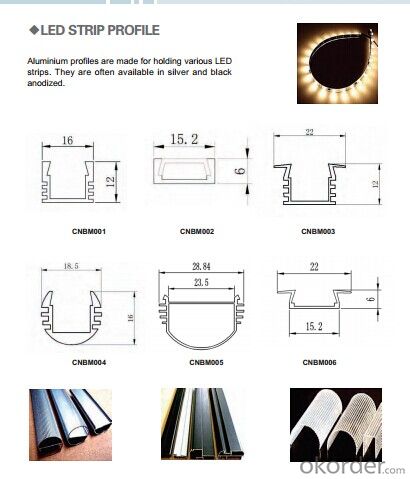
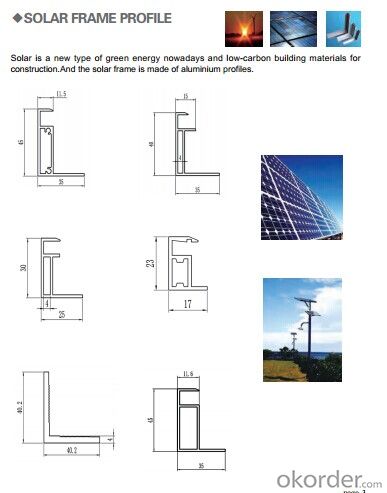
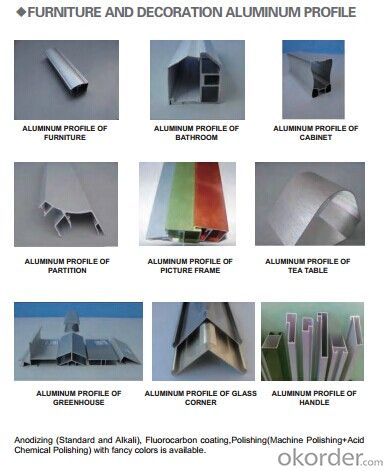
FAQ:
1. What is the form of payment?
Normally 30% TT, L/C at sight
2. Type of quotation?
FOB, CFR, CIF
3. Port of loading?
Shenzhen/Guangzhou port
4. Delivery time?
15-20 days after client’s deposit
- Q: How do you install aluminum profiles?
- To install aluminum profiles, follow these steps: 1. Measure and cut the profiles to the desired length using a saw with a fine-tooth blade. Make sure to wear safety goggles and gloves while cutting. 2. Clean the surface where the profiles will be installed. Remove any dirt, dust, or debris that may interfere with the installation. 3. Apply adhesive or silicone sealant along the back of the profile. This will help secure it to the surface and create a watertight seal. 4. Position the profile on the surface and press it firmly to ensure proper adhesion. Use a level to ensure it is straight and aligned correctly. 5. If necessary, use screws or fasteners to further secure the profile to the surface. Be sure to pre-drill pilot holes to prevent the aluminum from cracking. 6. Repeat the process for each profile, making sure to leave a small gap between them for expansion and contraction. 7. Once all the profiles are installed, clean off any excess adhesive or sealant. Use a damp cloth or sponge to wipe away any residue. 8. Allow the profiles to fully cure according to the manufacturer's instructions before applying any additional finishes or using the area. Remember to always refer to the manufacturer's instructions for specific installation guidelines and recommendations.
- Q: This question asks for methods to protect aluminum profiles from water damage during the installation and usage phases.
- <p>To prevent water damage to aluminum profiles during installation or use, follow these steps: 1. Ensure the aluminum profiles are properly sealed with a high-quality sealant to prevent water penetration. 2. Use corrosion-resistant fasteners and hardware to avoid rusting. 3. Install drainage systems to direct water away from the profiles. 4. Regularly inspect and maintain the profiles to identify and repair any damage promptly. 5. Avoid installing profiles in areas with high humidity or direct exposure to rain. 6. Use protective coatings or paints that are water-resistant and compatible with aluminum. 7. Keep the profiles clean and free from dirt or debris that can trap moisture. By following these precautions, you can significantly reduce the risk of water damage to aluminum profiles.</p>
- Q: What are the dimensions and sizes of aluminum profiles?
- The dimensions and sizes of aluminum profiles can vary greatly depending on their intended use and design. They can range from small and narrow profiles, such as 10mm x 10mm square tubes, to larger and wider profiles, such as 100mm x 100mm square tubes. Additionally, aluminum profiles can come in various shapes, including square, rectangular, round, and custom shapes, to accommodate different applications and structural requirements. It is important to consult specific product catalogs or manufacturers for precise dimensions and sizes of aluminum profiles.
- Q: Household aluminum profiles, which brand of cost-effective? Recommend!
- Cost performance is better, in our Nanshan factory is called a good fight,
- Q: Are aluminum profiles resistant to mold or mildew?
- Indeed, aluminum profiles exhibit a remarkable resistance to the growth of mold and mildew. This is due to the inherent properties of aluminum, which render it highly impervious to these unsightly invaders. In contrast to materials like wood, which are susceptible to moisture damage and consequently encourage the proliferation of mold and mildew, aluminum remains unaffected by such issues. Moreover, aluminum profiles are frequently treated with protective coatings or finishes that further bolster their resilience against the encroachment of mold and mildew. Consequently, aluminum profiles represent an ideal choice for areas that are prone to excessive humidity or moisture, such as bathrooms or kitchens, where the growth of mold and mildew is a prevalent concern.
- Q: Can aluminum profiles be used in corrosive environments?
- Aluminum profiles can be used in corrosive environments, but it is important to consider certain factors before making a decision. Aluminum is naturally resistant to corrosion due to the formation of a protective oxide layer on its surface. This layer acts as a barrier, preventing further corrosion. However, in highly corrosive environments such as areas with high humidity, saltwater exposure, or acidic conditions, the protective oxide layer may deteriorate over time. To enhance the resistance of aluminum profiles in corrosive environments, various measures can be taken. One option is to choose an aluminum alloy with higher corrosion resistance, such as aluminum alloys with a higher percentage of alloying elements like copper or zinc. These alloys are often referred to as marine-grade or corrosion-resistant alloys. Additionally, surface treatments like anodizing or powder coating can further improve the corrosion resistance of aluminum profiles. Anodizing involves the formation of a thicker and more durable oxide layer on the surface of the aluminum, while powder coating provides an additional protective layer that acts as a barrier against corrosive agents. Regular maintenance and cleaning are also crucial for preserving the corrosion resistance of aluminum profiles in corrosive environments. This includes removing any accumulated dirt or debris that may contain corrosive substances. In summary, while aluminum profiles can be used in corrosive environments, it is essential to select the appropriate alloy, consider surface treatments, and perform regular maintenance to ensure their long-term performance and durability.
- Q: Can aluminum profiles be customized?
- Yes, aluminum profiles can be customized according to specific requirements and designs. This customization can involve various factors such as size, shape, color, finish, and additional features to suit different applications and industries.
- Q: Are aluminum profiles suitable for playground equipment?
- Yes, aluminum profiles are suitable for playground equipment. Aluminum is a lightweight and durable material that is commonly used in various industries, including playground equipment manufacturing. It is known for its strength and resistance to corrosion, making it suitable for outdoor applications. Aluminum profiles provide structural stability and can withstand the weight and forces exerted during play. Additionally, aluminum is non-toxic and does not rust, ensuring the safety and longevity of the playground equipment. The versatility of aluminum allows for the creation of various shapes and designs, providing endless possibilities for innovative and attractive playground structures. Overall, aluminum profiles are a suitable choice for playground equipment due to their strength, durability, and safety features.
- Q: Can aluminum profiles be used for electrical applications?
- Aluminum profiles possess the capability to be utilized in electrical applications. Given its high conductivity, aluminum emerges as an ideal choice for facilitating electrical conduction. In the realm of electrical applications, aluminum profiles frequently find employment in power distribution systems, wiring conduits, and bus bars. By virtue of being lightweight and cost-effective, they present a favorable solution for electrical installations. Moreover, aluminum profiles exhibit commendable thermal conductivity, successfully aiding in the dissipation of heat emitted by electrical components. Nevertheless, it remains crucial to duly factor in the specific requirements of the electrical application at hand, ensuring that the aluminum profiles adhere to the requisite electrical safety standards and regulations.
- Q: What are the different installation methods for aluminum profiles?
- There are several different installation methods for aluminum profiles, depending on the specific application and requirements. 1. Screwed Installation: This is one of the most common methods for installing aluminum profiles. It involves using screws to attach the profiles to the desired surface. The profiles typically have pre-drilled holes to facilitate this process. Screwed installation provides a secure and stable connection, making it suitable for various applications. 2. Welded Installation: In some cases, aluminum profiles are welded together to create a strong and seamless joint. This method is commonly used in structural applications where high strength and rigidity are required. Welded installation can provide a more permanent and durable connection, but it requires specialized equipment and expertise. 3. Bolted Installation: Bolted installation involves using bolts and nuts to connect aluminum profiles. This method offers flexibility as it allows for easy disassembly and reassembly if needed. Bolted installation is commonly used in applications where frequent adjustments or modifications are required. 4. Adhesive Installation: Adhesive installation involves using specialized adhesives or bonding agents to attach aluminum profiles to the desired surface. This method is particularly useful when a seamless and aesthetically pleasing finish is desired, as it eliminates the need for visible screws or fasteners. Adhesive installation is commonly used in applications such as interior design, signage, and display systems. 5. Clamped Installation: Clamping is another method for installing aluminum profiles, especially in applications where a non-permanent connection is required. Clamps or brackets are used to secure the profiles in place, allowing for easy adjustment or removal. Clamped installation is commonly used in applications such as exhibition booths, temporary structures, or modular systems. It is important to consider the specific requirements of the project and consult with professionals or manufacturers to determine the most suitable installation method for aluminum profiles. Factors such as load-bearing capacity, aesthetics, ease of installation, and maintenance should be taken into account to ensure a successful installation.
Send your message to us
Aluminum Strut Profiles 6061 Aluminum Profile Extrusion
- Loading Port:
- China Main Port
- Payment Terms:
- TT OR LC
- Min Order Qty:
- -
- Supply Capability:
- -
OKorder Service Pledge
OKorder Financial Service
Similar products
Hot products
Hot Searches
Related keywords
